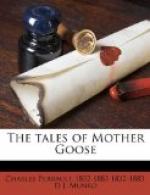In this book Mr. Deulin inclines to the view that the stories as first published by Perrault were not really written by him, but by his little son of ten or eleven, to whom Perrault told the stories as he had gathered them up with the intention of rendering them in verse after the manner of La Fontaine. The lad had an excellent memory, much natural wit, and a great gift of expression. He loved the stories his father told him and thoroughly enjoyed the task his father set him of rewriting them from memory, as an exercise. This was so happily done, in such a fresh, artless, and engaging style, exactly befitting the subjects of the stories, that the father found the son’s version better than the one he had contemplated and gave that to the world instead.
These stories made their way slowly in England at first, but in the end they nearly eclipsed the native fairy tales and legends, which, owing to Puritan influence, had been frowned upon and discouraged until they were remembered only in the remoter districts, and told only by the few who had not come under its sway. Indeed, the Puritanical objection to nursery lore of all kinds still lingers in some corners of England.
The stories of Perrault came in just when the severer manifestations of Puritanism were beginning to decline, and they have since become as much a part of English fairy lore as the old English folk and fairy tales themselves. These latter, thanks to Mr. Joseph Jacob, Mr. Andrew Lang, Mr. E.S. Hartland, and others, have been unearthed and revived, and prove to have lost nothing of their power of taking hold upon the minds of the little folk.
Perrault says of his collection that it is certain these stories excite in the children who read them the desire to resemble those characters who become happy, and at the same time they inspire them with the fear of the consequences which happen to those who do ill deeds; and he claims that they all contain a very distinct moral which is more or less evident to all who read them.
Emerson says: “What Nature at one time provides for use, she afterwards turns to ornament,” and Herbert Spencer, following out this idea, remarks that “the fairy lore, which in times past was matter of grave belief and held sway over people’s conduct, has since been transformed into ornament for The Midsummer Night’s Dream, The Tempest, The Fairy Queen, and endless small tales and poems; and still affords subjects for children’s story books, amuses boys and girls, and becomes matter for jocose allusion.”
Thus, also, Sir Walter Scott, in a note to “The Lady of the Lake,” says: “The mythology of one period would appear to pass into the romance of the next, and that into the nursery tales of subsequent ages,” and Max Mueller, in his “Chips from a German Workshop,” says: “The gods of ancient mythology were changed into the demigods and heroes of ancient epic poetry, and these demigods again became at a later age the principal characters of our nursery tales.”




